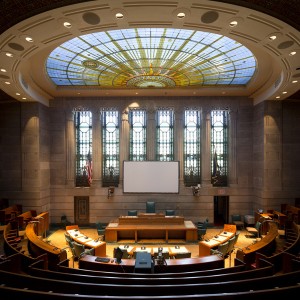06 May Round-up of Greece Analysis
In our earlier post, we reported the Supreme Court’s decision in Greece v. Galloway,  ruling that the Town’s prayer practice is not an unconstitutional establishment of religion. This post tracks some commentary on the case:
ruling that the Town’s prayer practice is not an unconstitutional establishment of religion. This post tracks some commentary on the case:
SCOTUSblog has been providing analysis of the divided decision:
The stark difference between the majority opinion in the Allegheny County case and the Court’s new opinion in the Town of Greece case illustrated the progress made by Justice Kennedy toward the Court’s full embrace — although for differing reasons among five Justices who determined the outcome – of the “coercion” test in determining whether a government practice amounted to an “establishment of religion” in violation of the First Amendment.
Eugene Volokh of UCLA School of Law provides his reactions:
The Court is unanimous in its view that, generally speaking, some legislative prayers are constitutionally permissible. In Marsh v. Chambers (1983), the Court split 6-3 on the subject, with Justices Brennan, Marshall, and Stevens arguing that such prayers generally violate the Establishment Clause (though 20 years before then, Justice Brennan — in voting to strike down school prayers — suggested that legislative prayers are allowed). But now all nine Justices agree with the Marsh result; even the dissent says, “pluralism and inclusion in a town hall can satisfy the constitutional requirement of neutrality; such a forum need not become a religion-free zone.” Indeed, the dissenters say they agree with Marsh, and don’t just follow it as a precedent.
The majority implies that the prayers might be impermissible if they “denigrate nonbelievers or religious minorities, threaten damnation, or preach conversion,” or if the prayer giver is chosen in a religiously discriminatory way. (In this case, the prayer givers rotated among local religious denominations, and the city apparently did not intentionally limit itself to some religions.) But there is no requirement that each prayer be “nonsectarian” or ecumenical; and there’s no requirement that the prayer givers rotate this way, and indeed many legislatures, including Congress and the Nebraska Legislature in Marsh, hire chaplains for extended lengths of time.
. . .
More broadly, the majority didn’t use this case as an opportunity to overturn the “endorsement” test that still has bare support in the precedents. This decision was narrowly focused on legislative prayer, a practice that has an unusually long and specific American tradition dating back to the Framing and even to the Continental Congress in 1774; it does not speak to how courts should consider other references to religion, such as on monuments, on city seals, in holiday displays, and the like. And while Justice Thomas repeated his view that the Establishment Clause should not be seen as incorporated by the Fourteenth Amendment against the states, no other Justice joined that view.
Eugene Kontorovich of Northwestern University School of Law also chimed in on The Volokh Conspiracy, defending the Court’s decision, indicating that it “changes, for the better, the use of a challenged practice’s history in interpreting the Establishment Clause.”
Today’s decision rejects the “grandfathering” model, at least as it was applied in Van Orden and McCreary. The legislative prayer in Town of Greece was an innovation dating only to 1999 – the same vintage as the McCreary Ten Commandments. Yet Justice Kennedy’s opinion sustaining it relied on the long history of legislative prayer in general, not the particular prayer in Greece. In the Ten Commandments context, this would make the question whether this kind of religious display has been around for a while, giving a presumption of validity to those that have. McCreary would have come out differently under this approach.
In effect, this inverts the grandfathering: anything of the kind historically allowed will continue to be allowed going forward (all things being equal), as opposed a rule that no more such things will be allowed.
The new approach makes more sense. A grandfathering policy implies the rules changed at some point, and that older displays will be tolerated merely for non-retroactivity type reasons. This raises the familiar Teaque question: if the new rule is so good, why not apply it across the board? And why is the Supreme Court innovating under color of the Establishment Clause?
The new approach to grandfathering starts with the assumption that it is not obvious what counts as an Establishment, but history and practice can help define it, as well as constraining the free hand of the Court.
Cullen Seltzer of the VA Locality Blog drew the following lessons:
-
The Court will be broadly tolerant of religious legislative invocations, even those that explicitly favor a single religion.
-
No Justice of the Court undertook to apply Lemon v. Kurtzman or the Endorsement test to this case, although Justice Breyer cited Lemon favorably, but only for the rationale of that case and not for its famous three-pronged (secular purpose, effect of enforcing or prohibiting a religious practice, excessive entanglement between religion and government).
-
Five Justices of the Court accepted the idea that examination of legislative prayer’s historical antecedents is a reasonable measure by which to gauge its permissibility. Indeed, the entire Court reaffirmed the vitality of Marsh v. Chambers which first approved legislative prayers.
-
Seven Justices hold to the view that even intangible coercion in legislative prayer may, in a future case, violate the Establishment Clause.
Image courtesy of Flickr by sah1365 (creative commons, no changes made).



